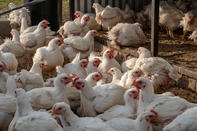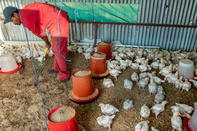Moisture management is the key to good poultry litter management. Litter that is too dry and dusty will cause dehydration and respiratory problems, while litter that is too wet will promote bacterial and fungal growth and cause excessive ammonia production.

Wet litter will also lead to higher incidents of blisters, skin burns, bruising, condemnations and downgrades. To make the most of poultry litter, moisture levels should be maintained between 20 percent and 25 percent.
When a handful is squeezed into a ball, the litter should slightly adhere. It is too wet if it sticks like a ball and too dry if it does not adhere at all.
Management tips

Good litter management starts with using the right bedding material. (Read more about bedding material here.) The material should be stored correctly before it is used, as it will be difficult to avoid wet litter problems if the bedding was already damp before it was placed in the poultry house.
Some farmers spread it out in the poultry house a week before new birds arrive, to ensure it is dry. The material should be turned regularly to keep it dry and friable. The birds will help with this by dust bathing and scratching in the material. Drinker design and management is critical when it comes to litter management.
Farmers should inspect the drinking system and fix leakages after birds have been removed and before new birds are introduced into the production system. The system should be closely monitored once production has started, to fix new leakages as soon as they are spotted. The same applies to foggers and evaporative cooling pads, which may lead to wet litter problems when faulty.
Water spillage at drinkers should also be avoided. Gradually raising drinkers to ease drinking as birds get older, has been found to reduce litter moisture by up to 7%. Drinkers should also be set at the correct pressure and cleaned properly to prevent spillages and ensure proper functioning.
Nipple drinkers have been found to result in less water spillage and wastage than bell drinkers. Nutrition has an impact on litter moisture levels, since certain dietary ingredients, such as salt, sodium bicarbonate, molasses, soya, amino acids and crude protein, when fed in excess, cause birds to drink and excrete more water.
Some of these ingredients may also lead to diarrhoea, which in addition to higher moisture levels will also lead to higher nitrogen levels. Heat stress and some medicines may have a similar effect. Stocking density, the number of birds kept per square meter, will have a direct impact on litter moisture levels.
It would be difficult to keep the litter at the right moisture levels if the stocking density is too high. The volume of bedding material used will have the same effect. Bedding that is spread too thinly will not be able to absorb as much moisture as thicker bedding. The volume of material used will depend on the production environment and bedding material that is used.
Environmental conditions, such as wet or humid weather, condensation or very cold temperatures may cause wet litter if the poultry house ventilation system and heating is not removing moisture effectively.
Condensation problems should be eliminated through the correct insulation of the building and water supply system. Ventilation and heating should be carefully manages to keep climatic conditions optimal.
By Glenneis Kriel